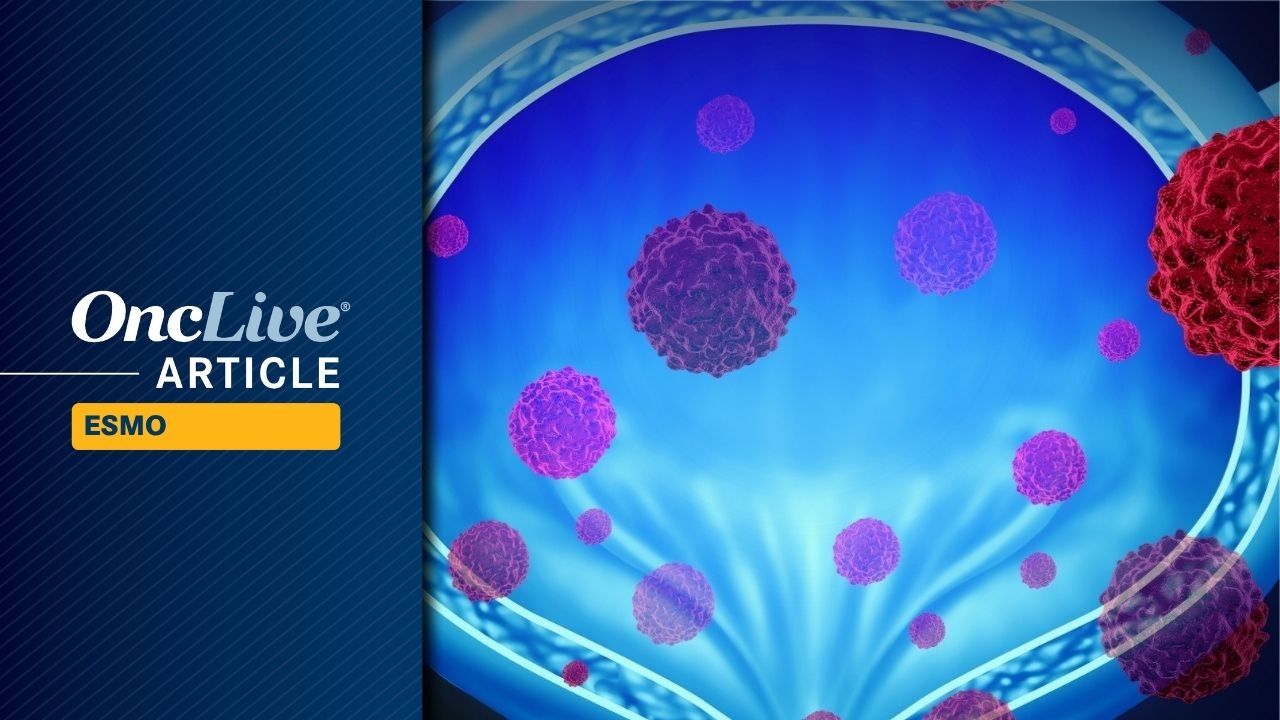Positive results from the DESTINY-Breast05 Phase III trial showed ENHERTU® (fam-trastuzumab deruxtecan-nxki) demonstrated a highly statistically significant and clinically meaningful improvement in invasive disease-free survival (IDFS) in patients with a high risk of disease recurrence. The trial compared ENHERTU with trastuzumab emtansine (T-DM1) as a post-neoadjuvant treatment (after surgery) in patients with HER2-positive early breast cancer with residual invasive disease in the breast and/or axillary lymph nodes after neoadjuvant treatment.
Results showed ENHERTU significantly reduced the risk of invasive disease recurrence or death by 53% compared with T-DM1 as a post-neoadjuvant treatment (based on an IDFS hazard ratio [HR] of 0.47, 95% confidence interval [CI] 0.34-0.66, p<0.0001). At three years, 92.4% of patients in the ENHERTU arm were alive and free of invasive disease, compared with 83.7% of those in the T-DM1 arm. The IDFS results were consistent across all prespecified subgroups.
ENHERTU also significantly reduced the risk of disease recurrence or death (disease-free survival [DFS]), a key secondary endpoint, by 53% (HR 0.47; 95% CI 0.34-0.66; p<0.0001). Further, ENHERTU lowered the risk of distant disease recurrence (distant recurrence-free interval [DRFI]) by 51% and the risk of brain metastases (brain metastasis-free interval [BMFI]) by 36% versus T-DM1.
Overall survival (OS) was not mature at the time of this planned interim analysis (2.9% maturity at data cut-off) and will be assessed in future analyses (HR 0.61; 95% CI 0.34-1.10).
Charles Geyer, MD, Chief Scientific Officer of the National Surgical Adjuvant Breast and Bowel Project Foundation (NSABP) Foundation, Professor of Medicine at the UPMC Hillman Cancer Center and principal investigator for the trial, said: “For patients with residual disease after neoadjuvant treatment, the post‑neoadjuvant setting represents a critical second opportunity to reduce recurrence risk, and in DESTINY‑Breast05 ENHERTU reduced the risk of early recurrence or death by 53 percent compared to the current standard of T‑DM1. These results, coupled with the safety data from the trial, are likely to transform clinical practice in the post-neoadjuvant setting for patients with high-risk disease, with the potential for ENHERTU to set a new standard of care.”
Susan Galbraith, Executive Vice President, Oncology Haematology R&D, AstraZeneca, said: “Progress in treating HER2-positive early breast cancer has been significant, yet managing patients at a higher-risk of recurrence remains challenging. These landmark data, alongside those from DESTINY-Breast11, underscore the potential of ENHERTU to become a foundational treatment in early-stage breast cancer, increasing the likelihood that more patients could be cured in this setting.”
Ken Takeshita, Global Head, R&D, Daiichi Sankyo, said: “The results of DESTINY-Breast05 demonstrate a clear benefit of ENHERTU over the current standard of care in patients with high-risk HER2-positive early breast cancer following surgery, improving their chance for sustained long-term outcomes. These results, coupled with the results of DESTINY-Breast11, illustrate the continued promise of ENHERTU to move earlier in the breast cancer treatment paradigm where it can have the greatest impact on the lives of patients.”
Summary of Results: DESTINY-Breast05i
|
Efficacy Measure
|
ENHERTU
(5.4 mg/kg; n=818)
|
T-DM1
(n=817)
|
|
IDFSii
|
|
3-year IDFS rate, %
|
92.4
|
83.7
|
|
|
HR 0.47 (95% CI 0.34-0.66); p<0.0001
|
|
DFSiii
|
|
3-year DFS rate, %
|
92.3
|
83.5
|
|
|
HR 0.47 (95% CI 0.34-0.66); p<0.0001
|
|
DRFIiv
|
|
3-year event-free rate, %
|
93.9
|
86.1
|
|
|
HR 0.49 (95% CI 0.34-0.71)
|
|
BMFIv
|
|
3-year event-free rate, %
|
97.6
|
95.8
|
|
|
HR 0.64 (95% CI 0.35-1.17)
|
|
OSvi
|
|
Survival at 3 years, %
|
97.4
|
95.7
|
|
|
HR 0.61 (95% CI 0.34-1.10)
|
TDM-1, trastuzumab emtansine; CI, confidence interval; HR, hazard ratio; IDFS, invasive disease-free survival; DFS, disease-free survival; DRFI, distant recurrence-free interval; BMFI, brain-metastasis-free interval; OS, overall survival
i Data cut-off July 2, 2025
ii IDFS is defined as the time from randomization until the date of first occurrence of one of the following events: recurrence of ipsilateral invasive breast tumor, recurrence of ipsilateral locoregional invasive breast cancer, contralateral invasive breast cancer, a distant disease recurrence or death from any cause; based on investigator assessment; statistically evaluated using the pre-specified hierarchical testing procedure
iii DFS is defined as the time between randomization and the date of the first occurrence of an IDFS event per STEEP criteria, including second primary non-breast cancer event, or contralateral or ipsilateral ductal carcinoma in situ (DCIS); based on investigator assessment; statistically evaluated using the pre-specified hierarchical testing procedure
iv DRFI is defined as the time between randomization and the date of distant breast cancer recurrence; based on investigator assessment
v BMFI is defined as the time between randomization and the date of documentation of brain metastases or leptomeningeal disease; based on investigator assessment
vi 2.9% maturity
The safety profile of ENHERTU observed in DESTINY-Breast05 was consistent with its known profile with no new safety concerns identified. Grade 3 or higher treatment emergent adverse events (AEs) rates were comparable between ENHERTU and T-DM1 (50.6% versus 51.9%). Rates of interstitial lung disease (ILD) were low in both arms with ILD events occurring in 9.6% of the ENHERTU arm and 1.6% of the T-DM1 arm. The majority of ILD events were low Grade (Grade 1 or 2). There were no Grade 3 or higher ILD events for T-DMI. There were seven Grade 3 events and no Grade 4 events in the ENHERTU arm. There were two Grade 5 events in the ENHERTU arm as determined by an independent adjudication committee.
The DESTINY-Breast05 results (abstract #LBA1) will be presented today during Presidential Symposium I alongside the results of the DESTINY-Breast11 Phase III trial (abstract #291O) at the European Society for Medical Oncology (ESMO) 2025 Congress in Berlin, Germany.
DESTINY-Breast05 was conducted in collaboration with the NSABP, the German Breast Group (GBG), Arbeitsgemeinschaft Gynäkologische Onkologie (AGO-B) and SOLTI Breast Cancer Research Group.
ENHERTU is a specifically engineered HER2-directed DXd antibody drug conjugate (ADC) discovered by Daiichi Sankyo and being jointly developed and commercialized by AstraZeneca and Daiichi Sankyo.
IMPORTANT SAFETY INFORMATION FOR ENHERTU® (fam-trastuzumab deruxtecan-nxki)
Indications
ENHERTU is a HER2-directed antibody and topoisomerase inhibitor conjugate indicated for the treatment of adult patients with:
|
WARNING: INTERSTITIAL LUNG DISEASE and EMBRYO-FETAL TOXICITY
- Interstitial lung disease (ILD) and pneumonitis, including fatal cases, have been reported with ENHERTU. Monitor for and promptly investigate signs and symptoms including cough, dyspnea, fever, and other new or worsening respiratory symptoms. Permanently discontinue ENHERTU in all patients with Grade 2 or higher ILD/pneumonitis. Advise patients of the risk and to immediately report symptoms.
- Exposure to ENHERTU during pregnancy can cause embryo-fetal harm. Advise patients of these risks and the need for effective contraception.
|
Contraindications
None.
Warnings and Precautions
Interstitial Lung Disease / Pneumonitis
Severe, life-threatening, or fatal interstitial lung disease (ILD), including pneumonitis, can occur in patients treated with ENHERTU. A higher incidence of Grade 1 and 2 ILD/pneumonitis has been observed in patients with moderate renal impairment. Advise patients to immediately report cough, dyspnea, fever, and/or any new or worsening respiratory symptoms. Monitor patients for signs and symptoms of ILD. Promptly investigate evidence of ILD. Evaluate patients with suspected ILD by radiographic imaging. Consider consultation with a pulmonologist. For asymptomatic ILD/pneumonitis (Grade 1), interrupt ENHERTU until resolved to Grade 0, then if resolved in ≤28 days from date of onset, maintain dose. If resolved in >28 days from date of onset, reduce dose 1 level. Consider corticosteroid treatment as soon as ILD/pneumonitis is suspected (e.g., ≥0.5 mg/kg/day prednisolone or equivalent). For symptomatic ILD/pneumonitis (Grade 2 or greater), permanently discontinue ENHERTU. Promptly initiate systemic corticosteroid treatment as soon as ILD/pneumonitis is suspected (e.g., ≥1 mg/kg/day prednisolone or equivalent) and continue for at least 14 days followed by gradual taper for at least 4 weeks.
HER2-Positive, HER2-Low, and HER2-Ultralow Metastatic Breast Cancer, HER2-Mutant NSCLC, and Solid Tumors (Including IHC 3+) (5.4 mg/kg)
In patients with metastatic breast cancer, HER2-mutant NSCLC, and other solid tumors treated with ENHERTU 5.4 mg/kg, ILD occurred in 12% of patients. Median time to first onset was 5.5 months (range: 0.9 to 31.5). Fatal outcomes due to ILD and/or pneumonitis occurred in 0.9% of patients treated with ENHERTU.
HER2-Positive Locally Advanced or Metastatic Gastric Cancer (6.4 mg/kg)
In patients with locally advanced or metastatic HER2-positive gastric or GEJ adenocarcinoma treated with ENHERTU 6.4 mg/kg, ILD occurred in 10% of patients. Median time to first onset was 2.8 months (range: 1.2 to 21).
Neutropenia
Severe neutropenia, including febrile neutropenia, can occur in patients treated with ENHERTU. Monitor complete blood counts prior to initiation of ENHERTU and prior to each dose, and as clinically indicated. For Grade 3 neutropenia (Absolute Neutrophil Count [ANC] <1.0 to 0.5 x 109/L), interrupt ENHERTU until resolved to Grade 2 or less, then maintain dose. For Grade 4 neutropenia (ANC <0.5 x 109/L), interrupt ENHERTU until resolved to Grade 2 or less, then reduce dose by 1 level. For febrile neutropenia (ANC <1.0 x 109/L and temperature >38.3º C or a sustained temperature of ≥38º C for more than 1 hour), interrupt ENHERTU until resolved, then reduce dose by 1 level.
HER2-Positive, HER2-Low, and HER2-Ultralow Metastatic Breast Cancer, HER2-Mutant NSCLC, and Solid Tumors (Including IHC 3+) (5.4 mg/kg)
In patients with metastatic breast cancer, HER2-mutant NSCLC, and other solid tumors treated with ENHERTU 5.4 mg/kg, a decrease in neutrophil count was reported in 65% of patients. Nineteen percent had Grade 3 or 4 decreased neutrophil count. Median time to first onset of decreased neutrophil count was 22 days (range: 2 to 939). Febrile neutropenia was reported in 1.2% of patients.
HER2-Positive Locally Advanced or Metastatic Gastric Cancer (6.4 mg/kg)
In patients with locally advanced or metastatic HER2-positive gastric or GEJ adenocarcinoma treated with ENHERTU 6.4 mg/kg, a decrease in neutrophil count was reported in 72% of patients. Fifty-one percent had Grade 3 or 4 decreased neutrophil count. Median time to first onset of decreased neutrophil count was 16 days (range: 4 to 187). Febrile neutropenia was reported in 4.8% of patients.
Left Ventricular Dysfunction
Patients treated with ENHERTU may be at increased risk of developing left ventricular dysfunction. Left ventricular ejection fraction (LVEF) decrease has been observed with anti-HER2 therapies, including ENHERTU. Assess LVEF prior to initiation of ENHERTU and at regular intervals during treatment as clinically indicated. Manage LVEF decrease through treatment interruption. When LVEF is >45% and absolute decrease from baseline is 10-20%, continue treatment with ENHERTU. When LVEF is 40-45% and absolute decrease from baseline is <10%, continue treatment with ENHERTU and repeat LVEF assessment within 3 weeks. When LVEF is 40-45% and absolute decrease from baseline is 10-20%, interrupt ENHERTU and repeat LVEF assessment within 3 weeks. If LVEF has not recovered to within 10% from baseline, permanently discontinue ENHERTU. If LVEF recovers to within 10% from baseline, resume treatment with ENHERTU at the same dose. When LVEF is <40% or absolute decrease from baseline is >20%, interrupt ENHERTU and repeat LVEF assessment within 3 weeks. If LVEF of <40% or absolute decrease from baseline of >20% is confirmed, permanently discontinue ENHERTU. Permanently discontinue ENHERTU in patients with symptomatic congestive heart failure. Treatment with ENHERTU has not been studied in patients with a history of clinically significant cardiac disease or LVEF <50% prior to initiation of treatment.
HER2-Positive, HER2-Low, and HER2-Ultralow Metastatic Breast Cancer, HER2-Mutant NSCLC, and Solid Tumors (Including IHC 3+) (5.4 mg/kg)
In patients with metastatic breast cancer, HER2-mutant NSCLC, and other solid tumors treated with ENHERTU 5.4 mg/kg, LVEF decrease was reported in 4.6% of patients, of which 0.6% were Grade 3 or 4.
HER2-Positive Locally Advanced or Metastatic Gastric Cancer (6.4 mg/kg)
In patients with locally advanced or metastatic HER2-positive gastric or GEJ adenocarcinoma treated with ENHERTU 6.4 mg/kg, no clinical adverse events of heart failure were reported; however, on echocardiography, 8% were found to have asymptomatic Grade 2 decrease in LVEF.
Embryo-Fetal Toxicity
ENHERTU can cause fetal harm when administered to a pregnant woman. Advise patients of the potential risks to a fetus. Verify the pregnancy status of females of reproductive potential prior to the initiation of ENHERTU. Advise females of reproductive potential to use effective contraception during treatment and for 7 months after the last dose of ENHERTU. Advise male patients with female partners of reproductive potential to use effective contraception during treatment with ENHERTU and for 4 months after the last dose of ENHERTU.
Additional Dose Modifications
Thrombocytopenia
For Grade 3 thrombocytopenia (platelets <50 to 25 x 109/L) interrupt ENHERTU until resolved to Grade 1 or less, then maintain dose. For Grade 4 thrombocytopenia (platelets <25 x 109/L) interrupt ENHERTU until resolved to Grade 1 or less, then reduce dose by 1 level.
Adverse Reactions
HER2-Positive, HER2-Low, and HER2-Ultralow Metastatic Breast Cancer, HER2-Mutant NSCLC, and Solid Tumors (Including IHC 3+) (5.4 mg/kg)
The pooled safety population reflects exposure to ENHERTU 5.4 mg/kg intravenously every 3 weeks in 2233 patients in Study DS8201-A-J101 (NCT02564900), DESTINY-Breast01, DESTINY-Breast02, DESTINY-Breast03, DESTINY-Breast04, DESTINY-Breast06, DESTINY-Lung01, DESTINY-Lung02, DESTINY-CRC02, and DESTINY-PanTumor02. Among these patients, 67% were exposed for >6 months and 38% were exposed for >1 year. In this pooled safety population, the most common (≥20%) adverse reactions, including laboratory abnormalities, were decreased white blood cell count (73%), nausea (72%), decreased hemoglobin (67%), decreased neutrophil count (65%), decreased lymphocyte count (60%), fatigue (55%), decreased platelet count (48%), increased aspartate aminotransferase (46%), increased alanine aminotransferase (44%), increased blood alkaline phosphatase (39%), vomiting (38%), alopecia (37%), constipation (32%), decreased blood potassium (32%), decreased appetite (31%), diarrhea (30%), and musculoskeletal pain (24%).
HER2-Positive Metastatic Breast Cancer
DESTINY-Breast03
The safety of ENHERTU was evaluated in 257 patients with unresectable or metastatic HER2-positive breast cancer who received at least 1 dose of ENHERTU 5.4 mg/kg intravenously once every 3 weeks in DESTINY-Breast03. The median duration of treatment was 14 months (range: 0.7 to 30) for patients who received ENHERTU.
Serious adverse reactions occurred in 19% of patients receiving ENHERTU. Serious adverse reactions in >1% of patients who received ENHERTU were vomiting, ILD, pneumonia, pyrexia, and urinary tract infection. Fatalities due to adverse reactions occurred in 0.8% of patients including COVID-19 and sudden death (1 patient each).
ENHERTU was permanently discontinued in 14% of patients, of which ILD/pneumonitis accounted for 8%. Dose interruptions due to adverse reactions occurred in 44% of patients treated with ENHERTU. The most frequent adverse reactions (>2%) associated with dose interruption were neutropenia, leukopenia, anemia, thrombocytopenia, pneumonia, nausea, fatigue, and ILD/pneumonitis. Dose reductions occurred in 21% of patients treated with ENHERTU. The most frequent adverse reactions (>2%) associated with dose reduction were nausea, neutropenia, and fatigue.
The most common (≥20%) adverse reactions, including laboratory abnormalities, were nausea (76%), decreased white blood cell count (74%), decreased neutrophil count (70%), increased aspartate aminotransferase (67%), decreased hemoglobin (64%), decreased lymphocyte count (55%), increased alanine aminotransferase (53%), decreased platelet count (52%), fatigue (49%), vomiting (49%), increased blood alkaline phosphatase (49%), alopecia (37%), decreased blood potassium (35%), constipation (34%), musculoskeletal pain (31%), diarrhea (29%), decreased appetite (29%), headache (22%), respiratory infection (22%), abdominal pain (21%), increased blood bilirubin (20%), and stomatitis (20%).
HER2-Low and HER2-Ultralow Metastatic Breast Cancer
DESTINY-Breast06
The safety of ENHERTU was evaluated in 434 patients with unresectable or metastatic HER2-low (IHC 1+ or IHC 2+/ISH-) or HER2-ultralow (IHC 0 with membrane staining) breast cancer who received ENHERTU 5.4 mg/kg intravenously once every 3 weeks in DESTINY-Breast06. The median duration of treatment was 11 months (range: 0.4 to 39.6) for patients who received ENHERTU.
Serious adverse reactions occurred in 20% of patients receiving ENHERTU. Serious adverse reactions in >1% of patients who received ENHERTU were ILD/pneumonitis, COVID-19, febrile neutropenia, and hypokalemia. Fatalities due to adverse reactions occurred in 2.8% of patients including ILD (0.7%); sepsis (0.5%); and COVID-19 pneumonia, bacterial meningoencephalitis, neutropenic sepsis, peritonitis, cerebrovascular accident, general physical health deterioration (0.2% each).
ENHERTU was permanently discontinued in 14% of patients. The most frequent adverse reaction (>2%) associated with permanent discontinuation was ILD/pneumonitis. Dose interruptions due to adverse reactions occurred in 48% of patients treated with ENHERTU. The most frequent adverse reactions (>2%) associated with dose interruption were COVID-19, decreased neutrophil count, anemia, pyrexia, pneumonia, decreased white blood cell count, and ILD. Dose reductions occurred in 25% of patients treated with ENHERTU. The most frequent adverse reactions (>2%) associated with dose reduction were nausea, fatigue, decreased platelet count, and decreased neutrophil count.
The most common (≥20%) adverse reactions, including laboratory abnormalities, were decreased white blood cell count (86%), decreased neutrophil count (75%), nausea (70%), decreased hemoglobin (69%), decreased lymphocyte count (66%), fatigue (53%), decreased platelet count (48%), alopecia (48%), increased alanine aminotransferase (44%), increased blood alkaline phosphatase (43%), increased aspartate aminotransferase (41%), decreased blood potassium (35%), diarrhea (34%), vomiting (34%), constipation (32%), decreased appetite (26%), COVID-19 (26%), and musculoskeletal pain (24%).
DESTINY-Breast04
The safety of ENHERTU was evaluated in 371 patients with unresectable or metastatic HER2-low (IHC 1+ or IHC 2+/ISH-) breast cancer who received ENHERTU 5.4 mg/kg intravenously once every 3 weeks in DESTINY-Breast04. The median duration of treatment was 8 months (range: 0.2 to 33) for patients who received ENHERTU.
Serious adverse reactions occurred in 28% of patients receiving ENHERTU. Serious adverse reactions in >1% of patients who received ENHERTU were ILD/pneumonitis, pneumonia, dyspnea, musculoskeletal pain, sepsis, anemia, febrile neutropenia, hypercalcemia, nausea, pyrexia, and vomiting. Fatalities due to adverse reactions occurred in 4% of patients including ILD/pneumonitis (3 patients); sepsis (2 patients); and ischemic colitis, disseminated intravascular coagulation, dyspnea, febrile neutropenia, general physical health deterioration, pleural effusion, and respiratory failure (1 patient each).
ENHERTU was permanently discontinued in 16% of patients, of which ILD/pneumonitis accounted for 8%. Dose interruptions due to adverse reactions occurred in 39% of patients treated with ENHERTU. The most frequent adverse reactions (>2%) associated with dose interruption were neutropenia, fatigue, anemia, leukopenia, COVID-19, ILD/pneumonitis, increased transaminases, and hyperbilirubinemia. Dose reductions occurred in 23% of patients treated with ENHERTU. The most frequent adverse reactions (>2%) associated with dose reduction were fatigue, nausea, thrombocytopenia, and neutropenia.
The most common (≥20%) adverse reactions, including laboratory abnormalities, were nausea (76%), decreased white blood cell count (70%), decreased hemoglobin (64%), decreased neutrophil count (64%), decreased lymphocyte count (55%), fatigue (54%), decreased platelet count (44%), alopecia (40%), vomiting (40%), increased aspartate aminotransferase (38%), increased alanine aminotransferase (36%), constipation (34%), increased blood alkaline phosphatase (34%), decreased appetite (32%), musculoskeletal pain (32%), diarrhea (27%), and decreased blood potassium (25%).
HER2-Mutant Unresectable or Metastatic NSCLC (5.4 mg/kg)
DESTINY-Lung02 evaluated 2 dose levels (5.4 mg/kg [n=101] and 6.4 mg/kg [n=50]); however, only the results for the recommended dose of 5.4 mg/kg intravenously every 3 weeks are described below due to increased toxicity observed with the higher dose in patients with NSCLC, including ILD/pneumonitis.
The safety of ENHERTU was evaluated in 101 patients with HER2-mutant unresectable or metastatic NSCLC who received ENHERTU 5.4 mg/kg intravenously once every 3 weeks until disease progression or unacceptable toxicity in DESTINY-Lung02. Nineteen percent of patients were exposed for >6 months.
Serious adverse reactions occurred in 30% of patients receiving ENHERTU.Serious adverse reactions in >1% of patients who received ENHERTU were ILD/pneumonitis, thrombocytopenia, dyspnea, nausea, pleural effusion, and increased troponin I. Fatality occurred in 1 patient with suspected ILD/pneumonitis (1%).
ENHERTU was permanently discontinued in 8% of patients. Adverse reactions which resulted in permanent discontinuation of ENHERTU were ILD/pneumonitis, diarrhea, decreased blood potassium, hypomagnesemia, myocarditis, and vomiting. Dose interruptions of ENHERTU due to adverse reactions occurred in 23% of patients. Adverse reactions which required dose interruption (>2%) included neutropenia and ILD/pneumonitis. Dose reductions due to an adverse reaction occurred in 11% of patients.
The most common (≥20%) adverse reactions, including laboratory abnormalities, were nausea (61%), decreased white blood cell count (60%), decreased hemoglobin (58%), decreased neutrophil count (52%), decreased lymphocyte count (43%), decreased platelet count (40%), decreased albumin (39%), increased aspartate aminotransferase (35%), increased alanine aminotransferase (34%), fatigue (32%), constipation (31%), decreased appetite (30%), vomiting (26%), increased alkaline phosphatase (22%), and alopecia (21%).
HER2-Positive Locally Advanced or Metastatic Gastric Cancer (6.4 mg/kg)
The safety of ENHERTU was evaluated in 187 patients with locally advanced or metastatic HER2-positive gastric or GEJ adenocarcinoma in DESTINY-Gastric01. Patients intravenously received at least 1 dose of either ENHERTU (N=125) 6.4 mg/kg every 3 weeks or either irinotecan (N=55) 150 mg/m2 biweekly or paclitaxel (N=7) 80 mg/m2 weekly for 3 weeks. The median duration of treatment was 4.6 months (range: 0.7 to 22.3) for patients who received ENHERTU.
Serious adverse reactions occurred in 44% of patients receiving ENHERTU 6.4 mg/kg. Serious adverse reactions in >2% of patients who received ENHERTU were decreased appetite, ILD, anemia, dehydration, pneumonia, cholestatic jaundice, pyrexia, and tumor hemorrhage. Fatalities due to adverse reactions occurred in 2.4% of patients: disseminated intravascular coagulation, large intestine perforation, and pneumonia occurred in 1 patient each (0.8%).
ENHERTU was permanently discontinued in 15% of patients, of which ILD accounted for 6%. Dose interruptions due to adverse reactions occurred in 62% of patients treated with ENHERTU. The most frequent adverse reactions (>2%) associated with dose interruption were neutropenia, anemia, decreased appetite, leukopenia, fatigue, thrombocytopenia, ILD, pneumonia, lymphopenia, upper respiratory tract infection, diarrhea, and decreased blood potassium. Dose reductions occurred in 32% of patients treated with ENHERTU. The most frequent adverse reactions (>2%) associated with dose reduction were neutropenia, decreased appetite, fatigue, nausea, and febrile neutropenia.
The most common (≥20%) adverse reactions, including laboratory abnormalities, were decreased hemoglobin (75%), decreased white blood cell count (74%), decreased neutrophil count (72%), decreased lymphocyte count (70%), decreased platelet count (68%), nausea (63%), decreased appetite (60%), increased aspartate aminotransferase (58%), fatigue (55%), increased blood alkaline phosphatase (54%), increased alanine aminotransferase (47%), diarrhea (32%), decreased blood potassium (30%), vomiting (26%), constipation (24%), increased blood bilirubin (24%), pyrexia (24%), and alopecia (22%).
HER2-Positive (IHC 3+) Unresectable or Metastatic Solid Tumors
The safety of ENHERTU was evaluated in 347 adult patients with unresectable or metastatic HER2-positive (IHC 3+) solid tumors who received ENHERTU 5.4 mg/kg intravenously once every 3 weeks in DESTINY-Breast01, DESTINY-PanTumor02, DESTINY-Lung01, and DESTINY-CRC02. The median duration of treatment was 8.3 months (range 0.7 to 30.2).
Serious adverse reactions occurred in 34% of patients receiving ENHERTU. Serious adverse reactions in >1% of patients who received ENHERTU were sepsis, pneumonia, vomiting, urinary tract infection, abdominal pain, nausea, pneumonitis, pleural effusion, hemorrhage, COVID-19, fatigue, acute kidney injury, anemia, cellulitis, and dyspnea. Fatalities due to adverse reactions occurred in 6.3% of patients including ILD/pneumonitis (2.3%), cardiac arrest (0.6%), COVID-19 (0.6%), and sepsis (0.6%). The following events occurred in 1 patient each (0.3%): acute kidney injury, cerebrovascular accident, general physical health deterioration, pneumonia, and hemorrhagic shock.
ENHERTU was permanently discontinued in 15% of patients, of which ILD/pneumonitis accounted for 10%. Dose interruptions due to adverse reactions occurred in 48% of patients. The most frequent adverse reactions (>2%) associated with dose interruption were decreased neutrophil count, anemia, COVID-19, fatigue, decreased white blood cell count, and ILD/pneumonitis. Dose reductions occurred in 27% of patients treated with ENHERTU. The most frequent adverse reactions (>2%) associated with dose reduction were fatigue, nausea, decreased neutrophil count, ILD/pneumonitis, and diarrhea.
The most common (≥20%) adverse reactions, including laboratory abnormalities, were decreased white blood cell count (75%), nausea (69%), decreased hemoglobin (67%), decreased neutrophil count (66%), fatigue (59%), decreased lymphocyte count (58%), decreased platelet count (51%), increased aspartate aminotransferase (45%), increased alanine aminotransferase (44%), increased blood alkaline phosphatase (36%), vomiting (35%), decreased appetite (34%), alopecia (34%), diarrhea (31%), decreased blood potassium (29%), constipation (28%), decreased sodium (22%), stomatitis (20%), and upper respiratory tract infection (20%).
Use in Specific Populations
- Pregnancy: ENHERTU can cause fetal harm when administered to a pregnant woman. Advise patients of the potential risks to a fetus. There are clinical considerations if ENHERTU is used in pregnant women, or if a patient becomes pregnant within 7 months after the last dose of ENHERTU.
- Lactation: There are no data regarding the presence of ENHERTU in human milk, the effects on the breastfed child, or the effects on milk production. Because of the potential for serious adverse reactions in a breastfed child, advise women not to breastfeed during treatment with ENHERTU and for 7 months after the last dose.
- Females and Males of Reproductive Potential: Pregnancy testing: Verify pregnancy status of females of reproductive potential prior to initiation of ENHERTU. Contraception: Females: ENHERTU can cause fetal harm when administered to a pregnant woman. Advise females of reproductive potential to use effective contraception during treatment with ENHERTU and for 7 months after the last dose. Males: Advise male patients with female partners of reproductive potential to use effective contraception during treatment with ENHERTU and for 4 months after the last dose. Infertility: ENHERTU may impair male reproductive function and fertility.
- Pediatric Use: Safety and effectiveness of ENHERTU have not been established in pediatric patients.
- Geriatric Use: Of the 1741 patients with HER2-positive, HER2-low, or HER2-ultralow breast cancer treated with ENHERTU 5.4 mg/kg, 24% were ≥65 years and 4.9% were ≥75 years. No overall differences in efficacy within clinical studies were observed between patients ≥65 years of age compared to younger patients. There was a higher incidence of Grade 3-4 adverse reactions observed in patients aged ≥65 years (61%) as compared to younger patients (52%). Of the 101 patients with HER2-mutant unresectable or metastatic NSCLC treated with ENHERTU 5.4 mg/kg, 40% were ≥65 years and 8% were ≥75 years. No overall differences in efficacy or safety were observed between patients ≥65 years of age compared to younger patients. Of the 125 patients with HER2-positive locally advanced or metastatic gastric or GEJ adenocarcinoma treated with ENHERTU 6.4 mg/kg in DESTINY-Gastric01, 56% were ≥65 years and 14% were ≥75 years. No overall differences in efficacy or safety were observed between patients ≥65 years of age compared to younger patients. Of the 192 patients with HER2-positive (IHC 3+) unresectable or metastatic solid tumors treated with ENHERTU 5.4 mg/kg in DESTINY-PanTumor02, DESTINY-Lung01, or DESTINY-CRC02, 39% were ≥65 years and 9% were ≥75 years. No overall differences in efficacy or safety were observed between patients ≥65 years of age compared to younger patients.
- Renal Impairment: A higher incidence of Grade 1 and 2 ILD/pneumonitis has been observed in patients with moderate renal impairment. Monitor patients with moderate renal impairment more frequently. The recommended dosage of ENHERTU has not been established for patients with severe renal impairment (CLcr <30 mL/min).
- Hepatic Impairment: In patients with moderate hepatic impairment, due to potentially increased exposure, closely monitor for increased toxicities related to the topoisomerase inhibitor, DXd. The recommended dosage of ENHERTU has not been established for patients with severe hepatic impairment (total bilirubin >3 times ULN and any AST).
To report SUSPECTED ADVERSE REACTIONS, contact Daiichi Sankyo, Inc. at 1-877-437-7763 or FDA at 1-800-FDA-1088 or fda.gov/medwatch.
Please see accompanying full Prescribing Information, including Boxed WARNINGS, and Medication Guide.
Notes
Post neoadjuvant treatment for HER2-positive early breast cancer
Breast cancer is the second most common cancer and one of the leading causes of cancer-related deaths worldwide.1 More than two million breast cancer cases were diagnosed in 2022, with more than 665,000 deaths globally.1
HER2 is a tyrosine kinase receptor growth-promoting protein expressed on the surface of many types of tumors including breast cancer.2 HER2 protein overexpression may occur as a result of HER2 gene amplification and is often associated with aggressive disease and poor prognosis in breast cancer.2 Approximately one in five cases of breast cancer are considered HER2-positive.3
For patients with HER2-positive early breast cancer, achieving pCR with neoadjuvant treatment is the earliest indicator of improved long-term survival.4 However, approximately half of patients who receive neoadjuvant treatment do not reach pCR and have poorer long-term outcomes, putting them at increased risk of disease recurrence.5-9
Post-neoadjuvant therapy represents a key opportunity to minimize the risk of recurrence and prevent progression to metastatic disease for patients with residual disease. Despite receiving additional treatment with T-DMI in the post-neoadjuvant setting, approximately 20% of patients still experience invasive disease or death and no reduction in the risk of CNS recurrence.10,11 Once patients are diagnosed with metastatic disease, the five-year survival rate drops from nearly 90% to approximately 30%.12
New treatment options are needed in the early breast cancer setting to help reduce the likelihood of disease progression and improve long-term outcomes for more patients.
DESTINY-Breast05
DESTINY-Breast05 is a global, multicenter, randomized, open-label, Phase III trial evaluating the efficacy and safety of ENHERTU (5.4 mg/kg) versus T-DM1 in patients with HER2-positive early breast cancer with residual invasive disease in breast and/or axillary lymph nodes following neoadjuvant therapy and a high risk of recurrence. High risk of recurrence was defined as presentation with inoperable cancer (prior to neoadjuvant therapy) or pathologically positive axillary lymph nodes following neoadjuvant therapy.
The primary endpoint of DESTINY-Breast05 is investigator-assessed IDFS. IDFS is defined as the time from randomization until first recurrence, distant recurrence or death from any cause. The key secondary endpoint is investigator-assessed disease-free survival. Other secondary endpoints include OS, distant recurrence-free interval, brain metastases-free interval and safety.
DESTINY-Breast05 enrolled 1,635 patients in Asia, Europe, North America, Oceania and South America. For more information about the trial, visit ClinicalTrials.gov.
ENHERTU
ENHERTU is a HER2-directed ADC. Designed using Daiichi Sankyo’s proprietary DXd ADC Technology, ENHERTU is the lead ADC in the oncology portfolio of Daiichi Sankyo and the most advanced program in AstraZeneca’s ADC scientific platform. ENHERTU consists of a HER2-monoclonal antibody attached to a number of topoisomerase I inhibitor payloads (an exatecan derivative, DXd) via tetrapeptide-based cleavable linkers.
ENHERTU (5.4 mg/kg) is approved in more than 85 countries/regions worldwide for the treatment of adult patients with unresectable or metastatic HER2-positive (immunohistochemistry [IHC] 3+ or in-situ hybridization (ISH)+) breast cancer who have received a prior anti-HER2-based regimen, either in the metastatic setting or in the neoadjuvant or adjuvant setting, and have developed disease recurrence during or within six months of completing therapy based on the results from the DESTINY-Breast03 trial.
ENHERTU (5.4 mg/kg) is approved in more than 85 countries/regions worldwide for the treatment of adult patients with unresectable or metastatic HER2-low (IHC 1+ or IHC 2+/ISH-) breast cancer who have received a prior systemic therapy in the metastatic setting or developed disease recurrence during or within six months of completing adjuvant chemotherapy based on the results from the DESTINY-Breast04 trial.
ENHERTU (5.4 mg/kg) is approved in more than 45 countries/regions worldwide for the treatment of adult patients with unresectable or metastatic HR-positive, HER2-low (IHC 1+ or IHC 2+/ ISH-) or HER2-ultralow (IHC 0 with membrane staining) breast cancer, as determined by a locally or regionally approved test, that have progressed on one or more endocrine therapies in the metastatic setting based on the results from the DESTINY-Breast06 trial.
ENHERTU (5.4 mg/kg) is approved in more than 60 countries/regions worldwide for the treatment of adult patients with unresectable or metastatic non-small cell lung cancer (NSCLC) whose tumors have activating HER2 (ERBB2) mutations, as detected by a locally or regionally approved test, and who have received a prior systemic therapy based on the results from the DESTINY-Lung02 and/or DESTINY-Lung05 trials. Continued approval in China and the U.S. for this indication may be contingent upon verification and description of clinical benefit in a confirmatory trial.
ENHERTU (6.4 mg/kg) is approved in more than 70 countries/regions worldwide for the treatment of adult patients with locally advanced or metastatic HER2-positive (IHC 3+ or IHC 2+/ISH+) gastric or gastroesophageal junction (GEJ) adenocarcinoma who have received a prior trastuzumab-based regimen based on the results from the DESTINY-Gastric01, DESTINY-Gastric02 and/or DESTINY-Gastric06 trials. Continued approval in China for this indication may be contingent upon verification and description of clinical benefit in a confirmatory trial.
ENHERTU (5.4 mg/kg) is approved in more than 10 countries/regions worldwide for the treatment of adult patients with unresectable or metastatic HER2-positive (IHC 3+) solid tumors who have received prior systemic treatment and have no satisfactory alternative treatment options based on efficacy results from the DESTINY-PanTumor02, DESTINY-Lung01 and DESTINY-CRC02 trials. Continued approval for this indication may be contingent upon verification and description of clinical benefit in a confirmatory trial.
ENHERTU development program
A comprehensive global clinical development programme is underway evaluating the efficacy and safety of ENHERTU as a monotherapy or in combination or sequentially with other cancer medicines across multiple HER2-targetable cancers.
Daiichi Sankyo collaboration
AstraZeneca and Daiichi Sankyo entered into a global collaboration to jointly develop and commercialize ENHERTU in March 2019 and datopotamab deruxtecan-dlnk in July 2020, except in Japan where Daiichi Sankyo maintains exclusive rights for each ADC. Daiichi Sankyo is responsible for the manufacturing and supply of ENHERTU and datopotamab deruxtecan-dlnk.
AstraZeneca in breast cancer
Driven by a growing understanding of breast cancer biology, AstraZeneca is challenging, and redefining, the current clinical paradigm for how breast cancer is classified and treated to deliver even more effective treatments to patients in need – with the bold ambition to one day eliminate breast cancer as a cause of death.
AstraZeneca has a comprehensive portfolio of approved and promising compounds in development that leverage different mechanisms of action to address the biologically diverse breast cancer tumor environment.
With ENHERTU, AstraZeneca and Daiichi Sankyo are aiming to improve outcomes in previously treated HER2-positive, HER2-low and HER2-ultralow metastatic breast cancer, and are exploring its potential in earlier lines of treatment and in new breast cancer settings.
In HR-positive breast cancer, AstraZeneca continues to improve outcomes with foundational medicines fulvestrant and goserelin and aims to reshape the HR-positive space with first-in-class AKT inhibitor, capivasertib, the TROP2-directed ADC, datopotamab deruxtecan-dlnk, and next-generation oral SERD and potential new medicine camizestrant.
PARP inhibitor olaparib is a targeted treatment option that has been studied in early and metastatic breast cancer patients with an inherited BRCA mutation. AstraZeneca with Merck & Co., Inc. (known as MSD outside the US and Canada) continue to research olaparib in these settings. AstraZeneca is also exploring the potential of saruparib, a potent and selective inhibitor of PARP1, in combination with camizestrant in BRCA-mutated, HR-positive, HER2-negative advanced breast cancer.
To bring much-needed treatment options to patients with triple-negative breast cancer, an aggressive form of breast cancer, AstraZeneca is collaborating with Daiichi Sankyo to evaluate the potential of datopotamab deruxtecan-dlnk alone and in combination with immunotherapy durvalumab.
AstraZeneca in oncology
AstraZeneca is leading a revolution in oncology with the ambition to provide cures for cancer in every form, following the science to understand cancer and all its complexities to discover, develop and deliver life-changing medicines to patients.
The Company’s focus is on some of the most challenging cancers. It is through persistent innovation that AstraZeneca has built one of the most diverse portfolios and pipelines in the industry, with the potential to catalyze changes in the practice of medicine and transform the patient experience.
AstraZeneca has the vision to redefine cancer care and, one day, eliminate cancer as a cause of death.
AstraZeneca
AstraZeneca is a global, science-led biopharmaceutical company that focuses on the discovery, development, and commercialization of prescription medicines in Oncology, Rare Diseases, and BioPharmaceuticals, including Cardiovascular, Renal & Metabolism, and Respiratory & Immunology. Based in Cambridge, UK, AstraZeneca’s innovative medicines are sold in more than 125 countries and used by millions of patients worldwide. Please visit astrazeneca-us.com and follow the Company on Social Media @AstraZeneca.







